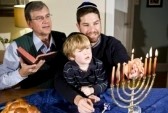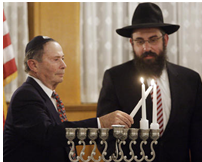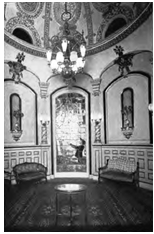Jewish Holidays and Festivals
The Story of Chanukah (Festival of Lights) - Dedication
Rededication of Temple after victory over Alexander's army;
Prophecy of God's temples again on the earth, baptism, endowments
Celebrating Chanukah
The Jewish ‘Festival of Lights”, commemorates the “Miracle of the Oil”. One of the most direct explanations of the name Chanukah is that it is related to the dedication (“chanukah”) of the Altar, [a centerpiece of the Holy Temple in Jerusalem].
Chanukah is probably one of the best known Jewish holidays,
not because of any great religious significance, but because of its
proximity to Christmas. Many non-Jews think of this holiday as the
Jewish Christmas, adopting many of the Christmas customs, such as
elaborate gift-giving and decoration. It is bitterly ironic that this
holiday, which has its roots in a revolution against assimilation  and the suppression of Jewish religion, has become the most assimilated, secular holiday on the Jewish calendar. and the suppression of Jewish religion, has become the most assimilated, secular holiday on the Jewish calendar.
Chanukah is the most important winter festival. It is celebrated for
eight days and is known as the Festival of Lights. It begins on the
twenty-fifth day of the Hebrew month Kislev (November-December). Every
night for eight nights the family gathers to light special candles, say
special prayers, and sing special songs. The candles are set in a
menorah (eight-branched candleholder).
 One candle is added to the menorah each night. The first night, only
the shammus (servant, and a light to all mankind) is lit and one
Chanukah candle. By the eighth night, all of the candles are lit.
One candle is added to the menorah each night. The first night, only
the shammus (servant, and a light to all mankind) is lit and one
Chanukah candle. By the eighth night, all of the candles are lit.
In the city of Tel Aviv every public building has its own menorah,
and each night during Hanukah another candle is lighted until eight of
them are burning in every menorah. In addition to the candles, all the
lights of the city are left on during the festival. For this reason Tel
Aviv is often called the City of Lights.
Sister Gale T. Boyd says, "This book unfolds to our view the symbolism as
found in the celebration of the Jewish Holy Days... A concise
explanation of Jewish history and beliefs as well as the Law of Moses
builds a bridge from Judaism to Mormonism."
What is the Historical Background?
These lighted candles celebrate the time long ago when the
Jewish people drove the Greeks out of one of their temples that had
been taken away from them in battle. There was only enough oil
available for the altar lamp in the temple to last for one day, but by
a miracle the oil in the lamp burned for eight days.
An evil Greek ruler began to oppress the Jews severely, placing a
Hellenistic priest in the First Temple, massacring Jews, prohibiting
the practice of the Jewish religion, making the reading of the Torah bible punishable by death, and desecrating the Temple by
requiring the sacrifice of pigs (a non-kosher animal) on the altar. Two
groups opposed him. They joined forces in a revolt. The revolution
succeeded and the Temple was rededicated.
According to tradition as recorded in the Talmud, at the time of the
rededication, there was very little oil left that had not been defiled
by the Greeks. Oil was needed for the menorah (candelabrum) in the
Temple, which was supposed to burn throughout the night every night.
There was only enough oil to burn for one day, yet miraculously, it
burned for eight days, the time needed to prepare a fresh supply of oil
for the menorah. The eight day festival was declared to commemorate this
miracle. Note that the holiday commemorates the miracle of the oil, not the military victory.
Recipe - Latkes
Latkes (potato cakes) are a favorite Hanukah treat, and here is an easy latke recipe
for you to make:
3 medium potatoes
1/4 teaspoon soda
1 chopped onion
1/4 cup flour
1 egg
oil for deep frying
Seasoning (ginger, nutmeg, salt, and pepper) to taste
Peel potatoes and grate very fine. Sprinkle with soda and squeeze out excess liquid.
Mix other ingredients and drop batter by spoonfuls into hot oil, frying until pancakes
are crisp on outside. Drain on paper, season, and serve hot.
Deeper into this History >>>
 We learn in the Talmud
(Avodah Zarah 52b) that the Hasmoneans removed and stored away the
Altar-stones which the Greeks had polluted with idolatry, and had to
build a new Altar. That is why the festival is called 'Chanukah' which
means 'dedication.' (source: Maharsha to Shabbos 21b) See also: I
Maccabees 4:44-9 and II Maccabees 10:2-4. This festival also refers to
the dedication of the Second Temple. (See Ezra 6) We learn in the Talmud
(Avodah Zarah 52b) that the Hasmoneans removed and stored away the
Altar-stones which the Greeks had polluted with idolatry, and had to
build a new Altar. That is why the festival is called 'Chanukah' which
means 'dedication.' (source: Maharsha to Shabbos 21b) See also: I
Maccabees 4:44-9 and II Maccabees 10:2-4. This festival also refers to
the dedication of the Second Temple. (See Ezra 6)
The story of Chanukah is the defeat of Antiochus III, the King of Syria, who reigned from 222-186 B.C. He had waged war with King Ptolemy of Egypt over the possession of the Land of Israel. Antiochus III was victorious and the Land of Israel was annexed to his empire. At first, he was favorable to the Jews, but when the Romans defeated him, he was forced to extract heavy taxes. When Antiochus died, his son Seleucus IV took over, and further oppressed the Jews.
The Hellenists’ idolatrous worship was another peril, as described in "the historical background" above. Yochanan, the
High Priest, foresaw the danger to Judaism from the penetration of
Syrian-Greek influence into the Holy Land. He opposed the introduction
of these things.
Eventually, Antiochus IV became the Syrian ruler. He was a tyrant. He suppressed Jewish law, made war against the Jews, forbidding them to worship and burning their Torah scrolls. Jews were forced to worship pagan gods, and prohibited from study of Torah under threat of death.
In the village of Modin lived the priest Mattiyahu. He refused to make sacrifices to Greek gods. He fled with his sons to the hills of Judea. They made raids upon enemy detachments and destroyed pagan altars. Judah was called "Maccabee," a word composed of the initial letters of the four Hebrew words for "Who is like You, O God."
The Syrians were eventually defeated by the Maccabees. A huge army fought in defense of the Temple. They reclaimed it and rededicated it in the year 139 b.c. on the 25th of Kislev. Since the golden menorah had been stolen by the Syrians, the Maccabees now made one of cheaper metal.
When they wanted to light the menorah, they found only a small cruse of pure olive oil bearing the seal of the High Priest Yochanan. It was sufficient to light only for one day. By a miracle of God, it continued to burn for eight days, till new oil was made available. That miracle proved that God had again taken His people under His protection. In memory of this, our sages appointed these eight days for annual thanksgiving and for lighting candles.
This deeper information was from a different group that gives very great detail and speaks about the resistance to Hellenization at the core of the issue, positioning that resistance to be the major point of Hanukkah. http://www.hebrew4christians.com/Holidays/Winter_Holidays/Chanukah/Spiritual_Warfare/spiritual_warfare.html.

"The Hanukkah holiday serves as a symbol and message of the triumph of
freedom over oppression, of spirit over matter, of light over
darkness," Rabbi Zippel said. "Especially in America, founded to
vigorously protect the right of every person to practice his or her
religion free from restraint and persecution, the Menorah takes on
profound significance, embodying both religious and constitutional
principles."
Christianity emerged as a development of Judaism, with the key focal
point differentiating Christian from non-Christian Jews being the
Christian belief that Jesus was the resurrected Messiah. The first
Christians (the disciples or students of Jesus) were essentially all
ethnically Jewish or Jewish proselytes. In other words, Jesus was
Jewish, preached to the Jewish people and called from them his first
disciples. Jewish Christians regarded "Christianity" as an affirmation
of every aspect of contemporary Judaism, with the addition of one extra
belief — that Jesus was the Messiah.
Solomon's Temple held the Ark of the Covenant in a room of the
temple referred to as the Holy of Holies. The presiding high priest
would enter into this room, said to contain the Shekhina (the presence
of God), once a year on Yom Kippur.
Why is the Chanukah story an important symbol for the necessity of temples of the Restored Church of Jesus Christ
The Church's Salt Lake Temple contains a Holy of Holies wherein
the church's president—acting as the Presiding High Priest—enters to
fulfill the relationship between the High Priest of Israel and God, in
accordance with the LDS interpretation of the Book of Exodus (Exodus
25:22).] Hence, this Holy of Holies is considered a modern cognate to
the inner sanctuary of the Tabernacle and Temple in Jerusalem.
Latter-day Saints believe that the Jews will one day rebuild a
Temple in Jerusalem, and that the Jews will restore the practice of
rituals of the Law of Moses within that Temple.
From the days of the Old Testament, the Lord has commanded His
people to build temples-sacred structures where He could teach, guide,
and bless them. For example, the Lord told the Israelites to build a
portable tabernacle that would be their temple while they traveled in
the wilderness (see Exodus 26-27;40:35). Additional Old Testament
references to temples are found in 2 Chronicles 5:1-14; 7:1-2 (Temple
of Solomon) and Ezra 3:1-13; 6:3 (Temple of Zerubbabel). When Jesus
Christ was on the earth, the only existing temple was known as the
Temple of Herod. Jesus was often found in this temple (see, for
example, Luke 2:40-49; Matthew 21:10-14).
After the rejection and deaths of Jesus' Apostles, there were no
temples on the earth for many centuries. When the gospel of Jesus
Christ was restored in the early 1800s, the Lord again commanded His
people to build temples (see D&C 88:119; see also section 95). The
earliest temples of the restored Church were built in Ohio, Illinois,
and eventually in Utah. As of December 2015 the Church has 148
operating temples, 14 under construction and 11 announced, around the
world. Regardless of the place or time period, temples are the most
sacred place on earth-a place where earth and heaven meet and where we
feel close to our Heavenly Father and Jesus Christ.
"A number of early Jewish and Christian documents deal with elements
found in modern LDS temples. As such,they are confirmation of the
antiquity of our temple rites.The volume of information is such that it
will not be possible to discuss all aspects in this brief paper. In
addition to some of the articles I have written, I would refer you to
the temple research written by such LDS researchers as Hugh Nibley,
John M. Lundquist, Donald W. Parry, Stephen D. Ricks, and Matthew B.
Brown. Just as an example, let me note that I have, to date, found
fifteen early Christian documents that speak of baptism for the dead,
along with several Mandaean and Jewish texts."
-by the late John A. Tvedtnes (M.A. in Linguistics and in Middle East Studies (Hebrew)), was a senior resident scholar with the Neal A. Maxwell Institute for Religious Scholarship at BYU
|  and the suppression of Jewish religion, has become the most assimilated, secular holiday on the Jewish calendar.
and the suppression of Jewish religion, has become the most assimilated, secular holiday on the Jewish calendar. One candle is added to the menorah each night. The first night, only
the shammus (servant, and a light to all mankind) is lit and one
Chanukah candle. By the eighth night, all of the candles are lit.
One candle is added to the menorah each night. The first night, only
the shammus (servant, and a light to all mankind) is lit and one
Chanukah candle. By the eighth night, all of the candles are lit. We learn in the Talmud
(Avodah Zarah 52b) that the Hasmoneans removed and stored away the
Altar-stones which the Greeks had polluted with idolatry, and had to
build a new Altar. That is why the festival is called 'Chanukah' which
means 'dedication.' (source: Maharsha to Shabbos 21b) See also: I
Maccabees 4:44-9 and II Maccabees 10:2-4. This festival also refers to
the dedication of the Second Temple. (See Ezra 6)
We learn in the Talmud
(Avodah Zarah 52b) that the Hasmoneans removed and stored away the
Altar-stones which the Greeks had polluted with idolatry, and had to
build a new Altar. That is why the festival is called 'Chanukah' which
means 'dedication.' (source: Maharsha to Shabbos 21b) See also: I
Maccabees 4:44-9 and II Maccabees 10:2-4. This festival also refers to
the dedication of the Second Temple. (See Ezra 6) 